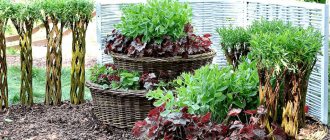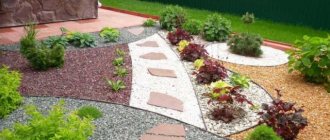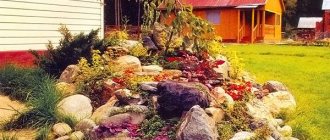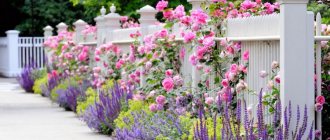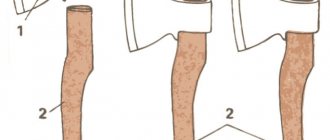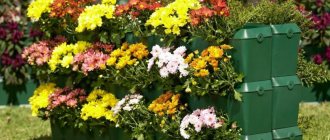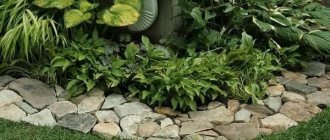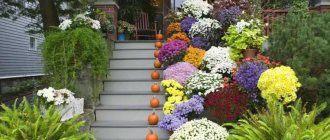A garden plot is not only a place where we grow fruits and vegetables. This is also a place for creativity. Gardeners often embody their creative ideas in creating flower beds. I always want something new and interesting. A suitable tool for expressing your individuality would be to create a flowerbed of stones with your own hands at the dacha. The combination of living, colorful, ever-changing plants with stationary and gray stones provides great opportunities for improvisation.
We have already devoted a large article to rockeries - a special type of flower bed made of stones. But the theme of compositions made of stones and plants is so exciting that you want to return to it again and again.
Do-it-yourself stone flowerbeds at the dacha will become the pride of the owner of the site.
Pros and cons of flower beds made of stones
Do-it-yourself stone construction is characterized by stability and durability. Such a flower bed can successfully diversify the look of a garden or adjacent area and divide the space into separate zones.
A stone flower garden is suitable for decorating nondescript corners near buildings, recreation areas and entrance areas.
Other advantages of a flowerbed with stones and flowers with your own hands:
- the composition is little susceptible to precipitation and other natural phenomena;
- the flower garden will always be unique;
- the stone island harmoniously combines with various architectural solutions on the site;
- Framing the flower bed with stone allows you to keep the soil from washing away and limits the flower bed from growing;
- the stone border does not require constant updating or special care;
- the design can be created on any type of coating and without preliminary preparation;
- finishing a flower bed with stone is easy to do with your own hands without the involvement of specialists;
- small stone is good for mulching.
Do-it-yourself flower beds made of stones near the house can be created either in a small area, or you can set aside a large space for the composition, creating an impressive rock garden.
One of the main disadvantages of a stone flower garden is the difficulty of acquiring materials, including due to their weight. Both small and large rocks have a high cost.
Advantages and disadvantages
Products of this kind can decorate any area, especially if they are complemented by ensembles of flower beds, artificial ponds and interesting architectural solutions for structures around them.
But the most significant advantages include:
- Durability. Decorative border stone is practically resistant to moisture, and weathering of caverns occurs over many thousands of years.
- Resistance to mechanical damage.
- Ergonomics. The rock and the plinth made from it can be folded into various geometric shapes.
Types of stone flower beds
DIY stone flower beds are varied. Compositions are created in different sizes, shapes and textures. Natural and artificial materials of various colors are used.
Standard flower bed
One of the simplest solutions for decorating a territory with your own hands. A flowerbed is a dedicated space in the form of a bed of various geometric shapes, usually round or rectangular. In this case, the stones are laid out along the borders of the island.
Such flower beds come in small sizes; they are created with your own hands around tree trunks or in a separate space. The flowerbed can be viewed from all sides or adjacent to the walls of a building or paths. Annuals and perennials, flowers and plants of different heights are planted on it.
Flowerbed arabesque
A flower garden that you create with your own hands in the form of a drawing. The flowerbed is decorated with stones in the form of various ornaments, winding patterns and inscriptions. Creating an arabesque takes up a lot of space.
For decoration, ground cover, as well as low plants and decorative chips of various shades are used. In such a composition, combinations of cultures are important. Colored pebbles are placed along the edge or inside the design, as well as between individual plants.
Rock garden
Rock garden using higher ground. A flower garden that replicates natural mountain landscapes. The basis of the rock garden are rocks of various sizes, which are arranged in the shape of a slide. The height and size of such a flowerbed made of stone at home is limited only by the area allocated for it.
Advice! Plants for the rock garden are chosen that are close to mountain species, with a strong root system.
Flowers, shrubs and dwarf tree species are planted on the hill. Plants are placed in the spaces between the stones so that the slide looks harmonious at different times of the year.
Rockery
A rock garden differs from a rock garden in its horizontal arrangement. To create a flower garden with your own hands, they also use a combination of stones and plants. Rocks for the composition are chosen in dull, harmonious shades. When creating a rock garden, clear outlines and borders are not used. Stone areas with plants are placed so that they look as if they were created naturally.
For decoration, large species are chosen, which form the basis of the flower garden, and small ones are used to create the background. Stones in rock gardens take up more space or are equal to plants. For compositions, dwarf forms of coniferous trees, low-growing shrubs, ground cover varieties and perennial grasses are used. Depending on the type of plant, rockeries are located both in sunny areas and in the shade, as well as near water bodies.
Gabion
Gabion is a metal structure in the form of a basket or mesh filled with stones. This product is strong and durable and holds its shape well. Gabions are used to frame flower islands and are used in conjunction with plants that act as hedges.
Any type of rock, including crushed rock, as well as flat or rounded rock, is suitable for filling the mesh structure. By laying the material in a color order, you can create different patterns, waves or stripes. Using a gabion, spiral, round, square or rectangular flower beds are made.
Advice! Gabions are especially suitable for small areas and tall flower beds.
Flowerbeds in the courtyard made of stones laid in a grid are installed near entrances, walls of buildings, verandas and paths. To create a gabion with your own hands, you will need welding skills, but ready-made mesh forms can also be purchased at garden centers.
Container flower garden
A container flower garden is built with your own hands on a stone fill, on which tubs with plants are installed. A flower bed can also be organized in a stone bowl.
The stone backing for the container island is made from medium-sized material, including the smallest fraction. Colors range from bright to muted or natural. Select any flowers and plants for the tub, according to the general style of the site. Containers in such a garden can be of various sizes, portable and stationary.
A stone bowl is a more fundamental solution; its installation will require special equipment.
Purpose of borders
In addition to decorating the site, stone frames also perform purely practical functions:
- separate garden areas;
- do not allow paths to be washed away by rain and melt water;
- prevent gravel from falling onto flower beds:
- inhibit the spread of soil from flower beds;
- limit the growth of lawn grass and weeds;
- during watering, do not allow water to flow outside the flower garden.
Ideas for flower beds made of stones
Do-it-yourself flowerbeds made of natural stone are a decorative element designed to create a well-groomed appearance of the area adjacent to the buildings. It’s easy to build a stone flower garden yourself from available materials and materials that are located on the site.
Ideas for flower beds made of stones:
Arbitrary flower bed. The stones in such a composition are laid out around the perimeter without securing anything. Such a flower garden, created with your own hands, can always be expanded or reduced by changing the number of stones, and can also be easily moved to another place. At the beginning of the season, adjustments to the curb are most often necessary due to the fact that loose cobblestones gradually slide down the soil.
Flower beds made of stone and concrete. For such a design, a permanent place is chosen. When rocks adhere to each other using concrete or cement, tall, beautiful flower beds are obtained.
Multi-tiered flower beds. Such designs are especially suitable for small areas. Plants in a flower garden are planted taking into account the flowering time so that all tiers look harmonious. On a multi-level flower bed you can place bright flowers or create a natural landscape in the style of a rock garden.
Flowerbeds in the form of a staircase. The flower bed is placed along the entrance or wall of the building. To create such a composition with your own hands, you will need flat stones or bricks.
Flowerbed borders. The flower bed is placed along a building or path, using stone to create a smooth or winding border.
Stone islands create accents to the property that last for years.
Types of stone used for borders
The following types are most in demand for the manufacture of these elements.
Basalt
The texture is porous and rough, but at the same time dense. Basalt has a dark gray tint. Demanded for strengthening road surfaces and foundations.
Slate
When examining the end of the slate, you can see barely visible delamination and various mineral inclusions. Due to its fragility, it is provided in the form of plinth with curved edges.
Limestone
Porous rock of dark cream color. Due to the specifics of its geological origin, prolonged exposure to moisture on limestone leads to its dissolution and delamination.
Granite
An unusually hard textured material that is offered to dacha owners in the finished form of slabs or curbs.
Important!
A curb made of natural stone using granite looks very presentable, but does not allow the construction of a high profile if ready-made curbs are used.
Sandstone
Sandstone is similar in morphology to limestone, but has a warmer shade and is also used in the form of plinth tiles with uneven edges.
Important!
The material is short-lived and least in demand in the decorative design of summer cottages.
Other
There are also various alternative options that allow you to use instead of borders made of decorative stone, structures made of rubble, shungite or a concrete monolith.
Important!
You can make a concrete monolith yourself and give it a decorative look by mixing it with stone chips or expanded clay.
Where to get stones for a flower bed
To create a flower garden with your own hands, use both simple and unprocessed stones and decorative stones for flower beds. The material is purchased at garden or landscape centers.
Rocks are also mined from quarrying and construction sites
The types of stones that can be used in the design of flower beds are varied. It can be decorative chips, pebbles, natural or artificial stone.
Decorative chips - this material includes fragments of various rocks, for example, marble and granite. Crumbs are usually presented in different fraction sizes and colors. The material can be natural shades or painted in many different colors. Using decorative chips, they create patterns and backgrounds. Colored material lifts the mood and gives a finished look to the flowerbed. The crumbs imitate mountain scree in alpine slides. The material can also serve as a mulch layer, under which weeds will not grow. The material is used both independently and in combination with larger breeds. To make the crumbs look aesthetically pleasing and not move, do it yourself using curb tape and a breathable lining layer, for example, geotextile.
Pebbles - can be river, lake or sea. It is a small, smooth, rounded stone. It is used in various climatic zones. Natural material has an unlimited service life. Pebbles, just like crumbs, are suitable for filling flower beds and mulching. The larger fraction is used to lay curbs.
Natural stone is an environmentally friendly and durable material. To create a flower garden with your own hands, the following types are suitable: sandstone, granite, limestone, tuff. The rock comes in various sizes, including crushed and solid boulders and blocks. Particularly suitable for creating stone gardens and large flower beds.
Artificial stone for flower beds is a material created in industrial conditions. This category includes both boulders and small pebbles, which are rolled in special devices. This material is more affordable than natural material. Artificial blocks are hollow inside, so they are light and easy to carry without special equipment.
To create a flowerbed with your own hands, the material can be found on your own plot when digging the soil for a vegetable garden. Cobblestone is found in natural conditions near rivers and springs. But transportation of stone, which is classified as a natural resource, may require a permit.
Non-standard borders made of basalt and granite
Basalt and granite are very beautiful rocks. These types of natural stone are highly durable. That is why they are often used to make borders.
In construction stores you can also find other names for curbs, such as curb stone and curb.
Basalt and granite borders, which will last for many decades, are an excellent solution for creating a monumental garden design. Do-it-yourself paving stone flowerbed? Installation will take a little time. Even a novice master can cope with this work.
Today, manufacturers offer their services for the production of non-standard forms of basalt and granite curbs, which differ from the sizes, reliefs and shapes specified in GOST. If you take advantage of this offer, you can create unique flower beds according to your own sketches, which only you will have.
How to make a flowerbed out of stones with your own hands
In order to lay out a flowerbed of stones with your own hands, you need to determine the place where it will be located temporarily or regularly. A stone flowerbed can successfully eliminate uneven surfaces and decorate any corner in the garden or near the house and veranda.
Small stone flowerbed
You can make a flowerbed at the dacha with your own hands from medium-sized stones very bright or in soothing colors. Decorative chips do not disrupt air exchange and do not interfere with plant development.
A small stone in a flower garden looks aesthetically pleasing throughout the season, including after precipitation.
How to make a flowerbed from stones with your own hands step by step:
- Create a sketch on paper or in a program, on which they mark the places where the plants will be located.
- In the selected area, mark the space using pegs with twine or painting the outline.
- Remove the top layer of soil to a depth of about 5 cm.
- Make holes in the soil, plant the plants and frame the planting site with border tape.
- The remaining space is covered with gravel.
- A geotextile is laid out over the resulting surface, which will prevent the mixing of decorative chips with drainage and soil, as well as the appearance of weeds.
- Stone chips are poured onto the geo-textile in one tone or separating its shades with a border tape.
- The border is made with a larger stone.
Flowers or plants in such a flower garden are planted pointwise so that the background is clearly visible. Decoration with decorative crumbs is also done on an already created flower bed. To do this, geotextiles with slots are placed under the plants and crumbs are also poured on top.
Large stone flower bed
You can make a rocky island in the style of a rock garden with your own hands both in the front part of the site and in the backyard. Plants characteristic of this type of flower bed tolerate partial shade well.
Advice! Rockeries are not recommended to be placed near trees due to the difficulty of clearing them of falling leaves.
In flooded areas, sand drainage is organized or drainage pipes are installed. In areas where moles often appear, a net is placed at the bottom of the flowerbed.
Stages of decorating a flower garden with stones:
- Remove the turf layer.
- Geotextiles are placed on the bottom.
- Large stones are placed on the surface of the covering material.
- Mark the places where the plants will be located. Holes are cut in the geotextile for planting plants. Holes are dug depending on the size of the root system. Soil of the required acidity is added to the planting holes, the plants are planted and watered.
- The remaining space is filled with crushed stone.
Coniferous plants, dwarf pines, and saxifrage are suitable for a stone flower bed. If desired, roses can be planted in such a composition.
Plants are placed taking into account their further growth. Trees and the largest stones are placed together, often creating the center of the composition.
We pour the fence for the path directly on the ground
You can make a border for a path with your own hands by pouring concrete directly into the formwork installed on the ground. To do this kind of work you will need the following tool:
This option is noticeably simpler, but the quality of the fence may not be the best. Installation of the curb with formwork is carried out according to the following scheme:
- A trench is prepared in accordance with the dimensions of the concrete fence and the height of the coating. The bottom of the groove is compacted.
- Sand is poured into the trench in a layer of 5-7 cm, which is moistened and compacted.
- Formwork made of smooth boards is installed. The structure is fixed with stakes, transverse slats and nails. In places with smooth curves, you can use plywood, plastic, sheet metal, OSB and even fiberboard.
- In those places where increased loads are expected, a reinforcement cage is placed in the formwork at a distance of at least 2 cm from the bottom and walls.
- Prepare a solution that consists of three parts sand, two parts crushed stone and one part cement. If necessary, dye is added to the concrete. The consistency of the solution should correspond to thick sour cream.
- The composition is poured into the mold, and transverse dividers from any roll waterproofing are placed into the concrete every 1-2 m. This will help avoid cracking of the curb when it hardens and changes in temperature. To remove air bubbles, the solution is pierced, and the fence boards are tapped with a hammer.
- The curb is covered and the formwork is not touched until the cement sets.
A homemade border, cast on site yourself, can be decorated with pieces of ceramic tiles pressed into the surface of the concrete. The sides protruding above the surface of the fence track can be decorated by attaching corrugated material to the walls of the formwork: rubber, plastic or metal plates.
How to paint stones for a flower bed
To diversify the decor, flower garden stones are painted. The small fraction is painted in one color; it most often serves as the background of a flower bed. The boulders depict landscapes and other paintings, as well as animals and various abstractions. Medium-sized stones are decorated in the form of representatives of flora and fauna, and images of vegetables or fruits are painted.
Images are applied according to a previously drawn up sketch or in random order. The stones are painted with their own hands both in advance and in the finished structure.
Advice! Before painting, stones are cleaned of dirt using a dry or wet method.
Paints are selected that are resistant to weather conditions so that the composition does not fade in the sun and the coating does not peel off due to precipitation. Acrylic, silicone or silicate paints, as well as varnishes, are suitable for this. You can decorate a flowerbed with stones with your own hands by decorating them with luminescent paint, then the structure will glow in the dark.
It is convenient to paint stones with a brush or a special spray bottle. The crumb is tinted first on one side, wait until it dries completely, turn it over and paint the remaining unpainted areas. The material can also be tinted entirely in a paint container.
Fencing construction process
The technology for laying artificial and natural stones of regular geometric shape, for example, rubble stone, is not much different from the technology for laying bricks.
But laying “wild” stones, which are known for their irregular shapes, requires additional knowledge and skills from the performer. In order to provide the masonry with good stability and the ability to withstand loads, the stones must be located according to the rules of “cutting” :
- If the surfaces where the stones come into contact with each other are perpendicular to the force of gravity acting on them, the masonry will become denser.
- The stones of each row are laid in such a way that they do not move.
- If the transverse and longitudinal vertical seams are through, the masonry will be divided into separate, unconnected columns.
Thus, stones touching vertically must be laid so that the area of their contact is maximum.
Their contact is not allowed by a plane, but by two points; in this case, sooner or later one of the stones will be destroyed. There is a dictionary of masonry terms. So, the upper and lower edges of the stone, which come into contact with other elements, are called beds , the long side edge is called spoon , the short side edge is called poke . A row of stones that face the outer surface of the wall with a long side edge is called a spoon row , a row facing a short side edge is a butt row .
Stones can be laid with or without the use of a fastening and binding mortar. It is by the presence of connecting elements that two masonry methods are distinguished:
- Wet - using a solution.
- Dry - without solution.
"Dry" option
The “dry” method is much more complicated, because requires careful selection of stones and scrupulous adjustment of them to each other. This technology is particularly difficult when working with natural materials, almost each of which has unique geometric parameters. The use of this technology requires the performer to comply with all the above cutting rules.
In order to increase durability and reliability, all voids between stones must be filled with binder mixtures.
Another method of improving the performance of dry masonry is to alternate rows of spoon and butt rows , which ensures better contact between them. If the structure does not bear a special load, then these voids can be filled with earth or sand. This technology is often used in the construction of low fences and barriers, as well as when laying curb stones.
"Wet" option
“Wet” masonry, due to its relative simplicity, is much more popular. It is used in the construction of permanent structures, which are solid monolithic structures. Thanks to the binding mixtures that fill all the voids between the stones, the structure receives the necessary rigidity.
Despite the fact that when using this technology, the accuracy of fitting the stones does not play such an important role, their correct arrangement is important here too. It allows you to significantly save on consumables, the cost of which is higher than the cost of the stone itself. In addition, correctly fitted masonry has a more perfect and respectable appearance.
When building a fence for a flower bed, it is recommended to use both technologies.
The lower rows of the fence can be laid out without the use of additional connecting elements from large stones, which are laid on a prepared sand bed and pressed into it.
“Wet” technology can be used to cladding the upper tiers of the fence using thin pieces of stone. When laying out rows, you must ensure that vertical seams do not form. To do this, each row must be shifted relative to the previous one.
Whatever masonry technology is chosen, and no matter how carefully the material is selected and adjusted, it is necessary to resort to mechanical processing of stones . Such processing can be divided into two types:
- Plinth. Crushing large stones into small ones.
- Removing sharp corners and other unnecessary irregularities from the surface.
To perform the first operation, it is recommended to use a sledgehammer weighing at least 5 kilograms; for the second, you will need a hammer weighing 2-3 kilograms.
Photos of flower beds made of stones with your own hands
Installation rules and technology
There are several nuances that are best familiarized with before starting work:
- You should choose a material that is combined with other elements - paving, paths.
- A stone border requires a solid foundation.
- The solution for fixing the masonry must be prepared in a ratio of 1:3 (cement, sand).
- The solution must be poured in layers. It is not recommended to lay out the entire border and then proceed to secure it.
In addition to the general requirements, you should definitely familiarize yourself with the rules for working with a specific material.
Borders for flower beds and garden paths: materials for manufacturing
Fences for flower beds are made from different materials. The list of common raw materials for structures includes:
- wood;
- rock;
- bricks;
- concrete;
- plastic;
- metal.
Budget design options are created from scrap materials:
- car tires;
- ropes;
- willow twigs.

